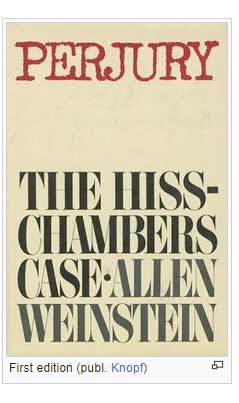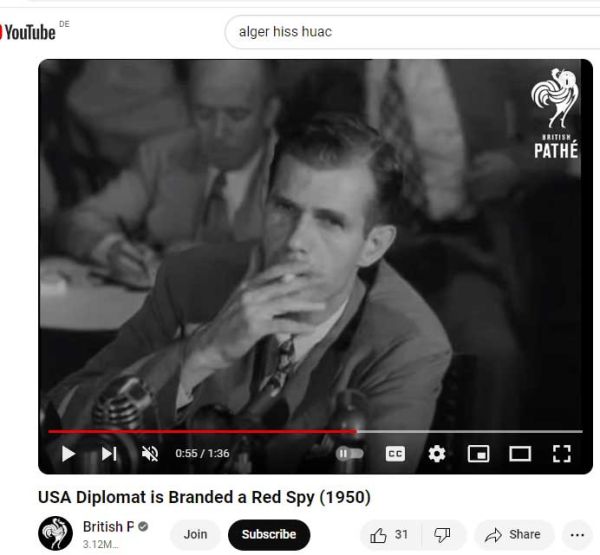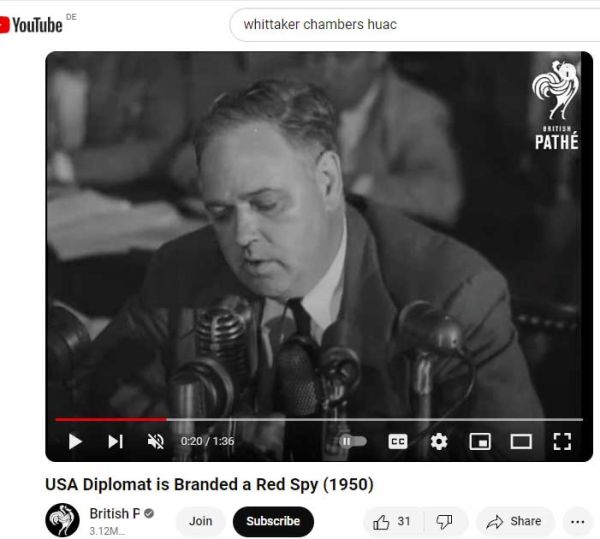The Alger Hiss Case
The Alger Hiss Case of the late-1940s is simply the most interesting historical event that I have ever read about. The more deeply I have studied it, the more its complex intrigues captivate me. As an experience in American jurisprudence, it ranks as a defining case, complete with all the legal bells and whistles, fascinating maneuvers and parries. Perjury: the Hiss-Chambers Case really needs a glossary to help readers comprehend the many legal terms.
Hiss should have been charged with espionage, but the "Statute of Limitations" has decreed that evidence in an espionage indictment is inadmissible if it is more than six years old. The first "perjury" trial ended in a "hung-jury". Following Hiss's conviction in the second trial, his attorneys appealed the verdict, then filed for a "Writ of Certiorari". A later generation of attorneys filed for a "Writ of Coram Nobis".
Even more important for me, the Hiss Case ranks as a watershed event in the history of American disunity, and as a modern definer of the incompatible value-systems battling for pre-eminence in the cultural battlefield. Accordingly, it has polarized generations of Americans ever since. It reminds me of the Alfred Dreyfus Case in France, which divided the French public so severely that party-hosts sent out invitations, promising their guests that no one attending the party would be allowed to talk about it.
My father returned home in 1945 in his Corporal's uniform, married my mother in 1946, and started a family. Years later, they attended a costume party, Mother in her nurse's uniform and Father in his Corporal's uniform--a quiet reminder of how they had met. The first inklings about the dimension and gravity of the Hiss Case appeared in 1948 with the testimony of a Time magazine journalist named Whittaker Chambers before the House Subcommittee on Un-American Activities. Three years ago, YouTube posted footage of his appearance before the Subcommittee. Chambers looked like a brooding career-solitary.
My father touched off my initial interest in the Hiss Case because he experienced it as it happened--from Chambers's sensational allegations, to Hiss's defamation-of-character lawsuit, lodged against Chambers. Chambers had only alleged that he and Hiss had belonged to the same Communist-Party cell, but when Chambers appeared on the radio-program "Meet the Press," the panel of journalists interviewing him only wanted to talk about espionage, which kept Chambers on edge. For one thing, the Congressmen of the House Subcommittee for Un-American Activities had already asked Chambers if he and Hiss had committed espionage, and under oath, he had denied it. So he could hardly admit to something that he had already denied under oath. (Even the Congressmen of the Subcommittee believed he had.)
Then Hiss filed a defamation-of-character lawsuit against Chambers. As long as he appeared before the House Subcommittee, Chambers could say anything he liked, and the law would construe it as "protected-speech". Once he repeated his allegations on "Meet the Press," however, he left himself vulnerable to litigation. Hiss lawyered-up and sued Chambers for $50,000 in damages for alleging his Communist-Party affiliation.
The lawsuit went badly for Chambers from the start. Facing bankruptcy if he lost, Chambers confided to his attorney that he could prove something even more serious than Communist Party membership, and his attorney told him that he really had no choice but to show his hand. So Chambers appeared in court the next day, and his attorney announced that Chambers wished to make a statement. He basically admitted that he had lied under oath, that he and Hiss had participated in an espionage conspiracy against the United States, and that he had belonged to an espionage-cell set up by the Soviet Union.
Moreover, Chambers had the documentary evidence to prove espionage. He had returned to his wife's home in Brooklyn, New York, to fetch a manila envelope that he had lodged in a disused dumbwaiter ten years earlier, right after his defection from the espionage cell. The evelope's contents consisted of 65 pages of typed material, four handwritten notes, and three reels of microfilm.
Because Chambers entered the papers into evidence in a Baltimore courtroom, journalists dubbed them the "Baltimore Papers." But the Department of Justice placed a "gag-order" on Chambers's papers, forbidding the newspapers to report on them. Although the papers pointed to Hiss's ties to the espionage cell, and revealed that he had perjured himself in denying it, Justice Department officials indicated that they intended to pursue a perjury-indictment only against Chambers.
Panicked that he might actually go to prison for perjury, Chambers turned to the Congressmen of the House Subcommittee for help. He also told them that he had already considered the risk that the Justice Department would suppress the evidence, and that he had held back the reels of microfilm to prevent that. The Subcommittee members instructed Chambers to turn over the microfilm evidence to no one but them.
The Subcommittee developed the microfilm, then went public with the results. Subcommittee members reported that the microfilm included 51 images of confidential State Department cablegrams from its out-stations in Europe and Asia; and that 14 of the 51 frames also carried Alger Hiss's initials, meaning that the cablegrams had passed through his office. In addition, the FBI believed that Priscilla Hiss had typed the 65 pages on her own typewriter, and that Alger Hiss had written the four notes--which contained more passages from State Department cablegrams.
Somewhat reluctantly, the wheels of justice began to turn, and Hiss had to appear before an unfriendly grand jury, not in Baltimore, Hiss's hometown, but in the District Court of Southern New York. The grand jury probed him for an explanation of how Chambers had obtained this material, and received mostly unsatisfactory answers. Afterwards, the grand jury made the decision to indict only Hiss, while Chambers basically turned "state's evidence." The legal wrangling that followed remains the most interesting bit of history that I have ever read about.



